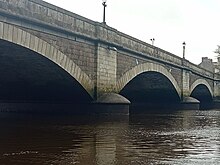
Back نهر بان ARZ Riu Bann Catalan River Bann (suba sa Hiniusang Gingharian, Northern Ireland, lat 55,17, long -6,77) CEB Bann Czech Банн CV Afon Bann Welsh Bann (Fluss) German Ποταμός Μπαν Greek Rivero Bann Esperanto Río Bann Spanish
| River Bann | |
|---|---|
 Overlooking the Lower Bann from Sandelford Bridge at Coleraine and the Riverside Retail Park on the eastern banks of the river | |
| Native name | An Bhanna (Irish) |
| Location | |
| Sovereign State | United Kingdom |
| Constituent Country | Northern Ireland |
| Physical characteristics | |
| Source | |
| • location | Slieve Muck, County Down |
| Mouth | |
• location | Atlantic Ocean at Portstewart |
• coordinates | 55°10′18″N 6°46′22″W / 55.17175°N 6.77264°W |
| Length | 129 kilometres (80 mi) |
| Basin size | 5,775 square kilometres (2,230 sq mi) |
| Discharge | |
| • average | 92 m3/s (3,200 cu ft/s) |
| Basin features | |
| Tributaries | |
| • left | Ulster Blackwater Clady River, Agivey River, Rhee River, Articlave River |
| • right | Ballymoney River |
The River Bann (from Irish: An Bhanna, meaning "the goddess";[1] Ulster-Scots: Bann Wattèr[2]) is the longest river in Northern Ireland, its length, Upper and Lower Bann combined, being 129 km (80 mi). However, the total length of the River Bann, including its path through the 30 km (19 mi) long Lough Neagh is 159 km (99 mi). Another length of the River Bann given is 90 mi.[3] The river winds its way from the southeast corner of Ulster[4] to the northwest coast,[5] pausing in the middle to widen into Lough Neagh. The River Bann catchment has an area of 5,775 km2.[6] The River Bann has a mean discharge rate of 92 m3/s.[7] According to C. Michael Hogan, the Bann River Valley is a settlement area for some of the first human arrivals in Ireland after the most recent glacial retreat.[8]

The river has played an important part in the industrialisation in Northern Ireland, especially in the linen industry. Today salmon and eel fisheries are the most important economic features of the river. The river is often used as a dividing line between the eastern and western areas of Northern Ireland, often labelled the "Bann divide". Towns, councils and businesses "west of the Bann" are often seen as having less investment and government spending than those to the east.[9] It is also seen as a religious, economic and political divide, with Catholics and Irish nationalists being in the majority to the west, and Ulster Protestants and unionists in the majority to the east; and with the financial and industrial capital of Greater Belfast to the east with the west of the Bann being more agricultural and rural.[10][11]

The Lough Neagh catchment drains 43%[12] of the landmass of Northern Ireland, as well as some border areas in the Republic of Ireland, all in Ulster. The Rivers Agency manages the water level in the lough using a barrage at Toome. The current drainage scheme was engineered by Major Percy Shepherd and was enabled by the Lough Neagh and Lower Bann Drainage and Navigation Act (Northern Ireland) 1955.[13] The levels are regulated between 12.45 metres and 12.6 metres above Ordnance Datum, as defined in the Lough Neagh (Levels) Scheme 1955 (as amended).[14]
- ^ "Place Names NI – Home". Placenamesni.org. Archived from the original on 15 October 2018. Retrieved 27 December 2018.
- ^ "Caird (Ulster Scots)". Ulster Museum. Archived from the original on 4 July 2017. Retrieved 1 March 2017.
- ^ Williams, Robert A (1872). Notes on River Basins. Longmans Green & Co. p. 69.
- ^ 54°10′01″N 6°04′59″W / 54.167°N 6.083°W
- ^ 55°09′47″N 6°46′05″W / 55.163°N 6.768°W
- ^ "Understanding and Managing Hydrological Extremes in the Lough Neagh Basin" (PDF). Opw.ie. Archived (PDF) from the original on 4 March 2016. Retrieved 27 December 2018.
- ^ Riverine Inputs and Direct Discharges to Convention Waters
Annex V Statistical information on river catchment areas
P. 76 (Convert 1,000m³/d into m³/s)"Archived copy" (PDF). Archived from the original (PDF) on 1 November 2014. Retrieved 19 October 2014.
{{cite web}}: CS1 maint: archived copy as title (link) - ^ Hogan, C. Michael (2011). P.Saundry & C.Cleveland (ed.). "Celtic Sea". Washington DC: Encyclopedia of Earth. National Council for Science and the Environment. Archived from the original on 2 June 2013. Retrieved 6 May 2011.
- ^ "What the Papers Say". BBC News. 5 May 2004. Archived from the original on 15 September 2019. Retrieved 31 May 2007.
- ^ "CAIN: CSC: Report: Register Of Research On Northern Ireland 1993 Edition". Cain.ulst.ac.uk. Archived from the original on 30 August 2007. Retrieved 27 December 2018.
- ^ "Study reveals East/West divide in employment figures". Strabane Chronicle. Archived from the original on 21 August 2008.
- ^ "Rivers Agency Website". Lough Neaghwater level maintenance. Archived from the original on 25 April 2012. Retrieved 21 May 2012.
- ^ "Lough Neagh and Lower Bann Drainage and Navigation Act (Northern Ireland) 1955". Legislation.gov.uk. Archived from the original on 2 April 2021. Retrieved 21 May 2012.
- ^ "Lough Neagh (Levels) Scheme (Confirmation) Order(Northern Ireland) 2004" (PDF). Legislation.gov.uk. Archived (PDF) from the original on 12 March 2021. Retrieved 21 May 2012.
© MMXXIII Rich X Search. We shall prevail. All rights reserved. Rich X Search